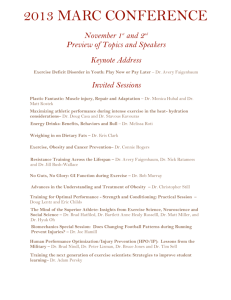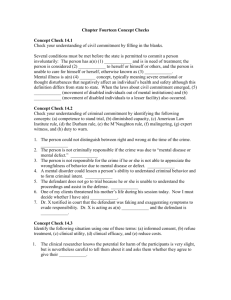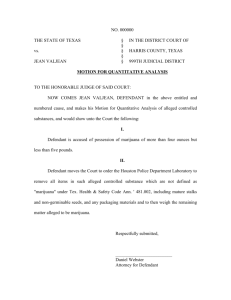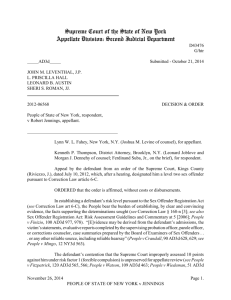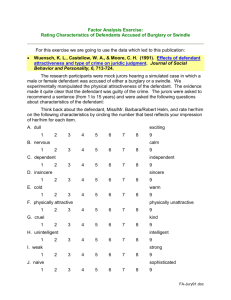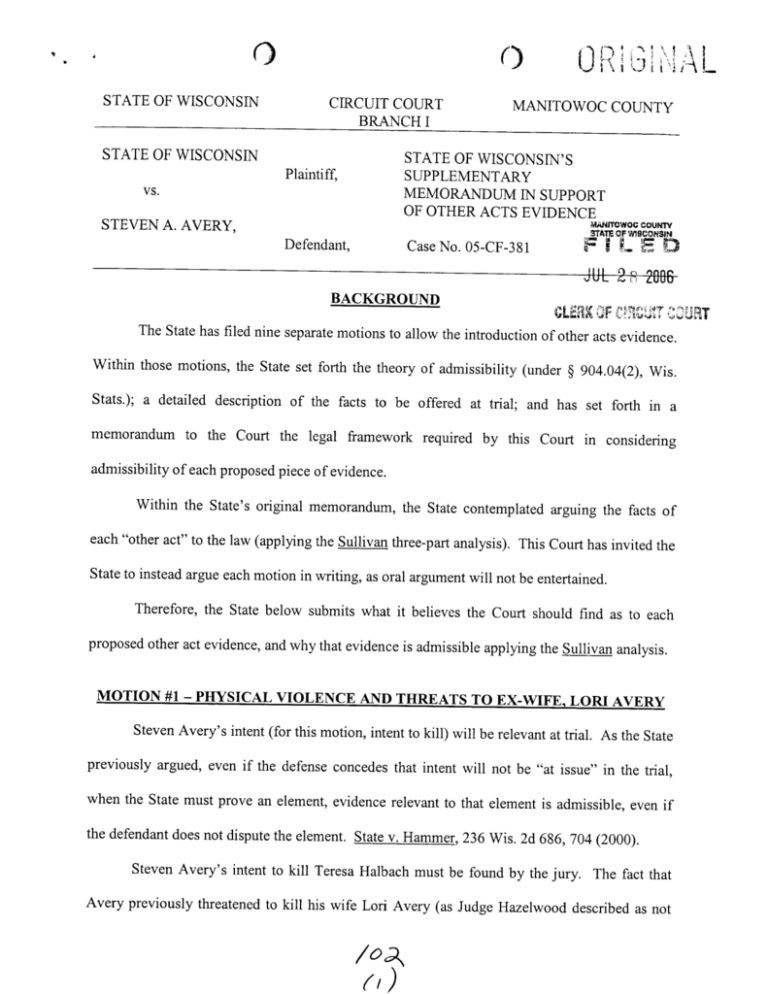
r)
STATE OF WISCONSIN
CIRCUIT COURT
BRANCH I
STATE OF WISCONSIN
tifti'iii,i ;\L
MANITOWOC COLTNTY
STATE OF WISCONSIN'S
SUPPLEMENTARY
MEMORANDTIM IN SUPPORT
OF OTHER ACTS EVIDENCE
Plaintiff,
vs.
STEVEN A. AVERY,
MAldIlq'tYOC COUiltY
grAI€ 0F'#t8coilgtH
Defendant.
llE
{
6. !
Case No. 05-CF-381
q,- r'Fr
3F,
ir
h
.q-S
BACKGROUND
SLEitK';F f;ift
fr
;iT':
;,"j p,T
The State has filed nine separate motions to allow the introduction of other acts
evidence.
Within those motions, the State set forth the theory of admissibility (under g04.04(Z), Wis.
S
Stats.);
a detailed description of the facts to be offered at trial; and has set forth in
memorandum
to the Court the legal
framework required
by this Court in
a
considering
admissibility of each proposed piece of evidence.
Within the State's original memorandum, the State contemplated arguing the facts of
each "other act" to the law (applyng the Sullivan three-part analysis). This Court has invited
the
State to instead argue each motion in writing, as oral argument
Therefore, the State below submits what
will not be entertained.
it believes the Court
should find as to each
proposed other act evidence, and why that evidence is admissible applyrng the Sullivan
analysis.
Steven Avery's intent (for this motion, intent to
previously argued, even
if
kill) will
be relevant at
trial. As the State
the defense concedes that intent will not be "at issue" in the trial,
when the State must prove an element, evidence relevant to that element is admissible, even
if
the defendant does not dispute the element. State v. Hammer, 236 Wis. Zd 6g6,704 (2000).
Steven Avery's intent to
kill
Teresa Halbach must be found
by the jury. The fact that
Avery previously threatened to kill his wife Lori Avery (as Judge Hazelwood described as not
/o
(r
simply
a threat to
kill
her, but a "grandiose mutilation-type scheme") is highly relevant. Avery's
history of physically assaultive behavior towards women (here Lori Avery) is also relevant as to
his intent to kill.
The defense suggests that the physical violence against Lori Avery, and the threats to
mutilate her, are too remote for this Court to deem them admissible. The fact that other acts are
distant in time does not end the inquiry. In considering time, courts take into account not only
the time that has passed, but also the opportunities presented over that period for the defendant to
repeat the acts. State v. Kuntz, 160 Wis. 2d722,747 (1991). Specifically, courts consider the
time that individuals spent incarcerated, and do not include that timeframe in the other
acts
remoteness analysis.
In Sanford v. State, 76 Wis. 2d72 (1977), the Wisconsin Supreme Court noted that any
issue as to remoteness of the prior incident is almost completely diffused by the fact that during
the time gap between the prior incident and the rape fthe current charged case], defendant was in
confinement in a correctional institution. Id. at p. 82. When the Court considered the time that
Sanford spent incarcerated, the span between the prior incident and the present offense became a
matter of days, not months or years. Id.
When considering Steven Avery's case, it would appear that the prior acts sought to be
introduced and the instant case may be separated by as much as 23 years. Under more critical
analysis, however, Steven Avery was incarcerated in one fashion or another for approximately
20 ofthose 23 years.
The animal cruelty conviction caused Steven Avery's probation for two burglary
convictions to be revoked on November 18, 1982, and Steven Avery was ordered to serve two
years prison concurrent to the nine-month sentence for animal
cruelty. Subsequent to his
release
from prison on the burglary charges in 80-CR-772,80-CR-173 and 80-CR-774 on August
(,)
12,
1983, Steven Avery was taken into custody on January 3, 1985, and charged with endangering
safety by conduct regardless of life (the incident regarding Sandra Morris). Avery was held in
the Manitowoc County Jail until bond was posted on February 14, 1985, and Avery
was
subsequently arrested on July 29, 1985, for first degree sexual assault, attempted murder and
false imprisonment. Avery was later sentenced to six years prison after his conviction for
endangering safety as well as felon in possession of a firearm as a repeater; those sentences ran
concurrent to a 32-year sentence for the sexual assault and attempted murder case, for which
Avery was later exonerated. Avery was released from prison on September l l, 2003.
Therefore, when removing periods of incarceration, instances of physical abuse to Lori
Avery and the instant homicide case are separated by no more than 3-ll2 years. This remoteness
analysis should be applied to each of the acts the State seeks to be introduced. committed orior to
Avery's incarceration in 1985.
The defendant's motive will also undoubtedly be at issue in this case. Althoueh not an
"element," motive is usually at issue in criminal prosecutions.
Motive is simply the state of mind or emotion that causes
a person
to act in a certain way;
the reasons which lead the mind to desire the result of the act. State v. Fishnick,
247,260 (1985). Evidence of a generalized urge, such
as
l2i
Wis.2d,
jealousy, has been admitted as motive
for murder. See State v. Wyss, 124 Wis. 2d681,712 (1985).
Finally, the defendant's "plan" to
Halbach
will
kill
also be relevant evidence for this
(rape, torture, mutilate and dispose of) Teresa
jury to consider. When considered in connection
with previous statements to inmates (demonstrating a clear plan to rape, torture and murder
young women), the defendant's acts of violence perpetrated against another woman, here Lori
Avery, bring the crimes committed against Ms. Halbach into sharper focus. Other acts necessary
()
to give a context of the story of the case have previously been approved as reasons for
admissibility. See State v. Bergeron, 162 wis. zd 527,529-31 (ct. App. 1991).
Finally, the defense "explanation" that Avery had a reason to be angry with his wife, Lori
Avery, and the argument that physical abuse perpetrated against her and threats to
kill
and
mutilate Lori should be distinguished from what happened to Teresa Halbach is simply an
attempt to distinguish the facts, while misdirecting this Court's attention from the true theory
of
admissibility. Tthe fact that this defendant previously engaged in substantial physical
abuse
of
and mutilate the mother
of
women, and further evidence exists of this defendant's threats to
kill
his children, is highly probative as to the defendant's intent, motive and plan.
MOTION #2 - PHYSICAL VIOLENCE TOWARDS
GIRLFRIEND JODI STACHOWSKI
The defendant's pattem of physical violence towards women continues with
Jodi
Stachowski, a woman Avery developed a relationship with after his release from prison in 2003.
Physical abuse towards Stachowski has included slapping, choking, punching and throwing to
the ground. The defense argues that this behavior is dissimilar to violence causing the death
of
Teresa Halbach (stabbing or shooting) and therefore is not relevant as to the defendant's intent or
motive.
Once again, the State argues that the defendant's violence towards women is highly
relevant on the issues of intent and motive, and though violence towards Ms. Halbach lead to her
death, that behavior is simply different in "degree" rather than different in "kind.,"
The State disagrees that it offers evidence of physical violence towards women to show
that the defendant is a "bad man," but rather argues its relevance for the jury to consider on
issues of intent, motive and plan.
()
The State should also be allowed to show the escalating nature of Avery's violence
torvards women, beginning
with slapping his ex-wife Lori Avery, continuing with punching
and
choking Jody Stachowski, and culminating with causing the death of Teresa Halbach. The
theory of the prosecution is that the defendant treated women as sexual objects, believed he was
"entitled" to physically abuse them and cause them harm, and intended to rape, torture
and
murder women; the acts committed against Teresa Halbach demonstrate the culmination of the
defendant's progression
of
physical violence towards women, and should therefore be
admissible.
MOTION
#3 _
ACT OF VIOLENCE TOWARDS AN ANIMAL (KILLING A CAT)
The State believes that the violence demonstrated towards a live cat on August 31,1982,
is highly relevant, and has such substantial probative value that it should be considered by the
jury.
The State's theory, as has been previously revealed to the Court, is that the defendant
exhibits sadistic qualities, and derives pleasure from causing pain (and death) to other living
beings. Soaking a live cat with gas and oil, and throwing it, alive, on a bonfire so clearly
demonstrates the defendant's sadistic personality, as to be highly relevant on issues of intent,
motive, plan and identity regarding the murder and mutilation of Ms. Halbach.
The State argues that facts at trial
defendant took a
will
include after stabbing Teresa Halbach, the
rifle and shot her several times, including in the head while in his
Eaarge.
Importantly, the cat in which Avery threw on the fire (alive), jumped off the fire, while burning,
and the defendant was forced to re-apply flammable liquid to the cat, and once again, throw the
cat on the fire until it burned to death. The State argues that to ensure a similar episode would
not occur with the victim, Teresa Halbach, the defendant "made sure" the victim was dea,il by
shooting her with a rifle (for up to ten times); without knowledge of the buming cat story, the
(')
(3
jury may be left to
speculate as to why the defendant would shoot Ms. Halbach so many times.
after having possibly caused life-ending injuries to her minutes before by stabbing.
The State agrees that burning a live cat is disgusting and sensational behavior, however, it
is behavior the defendant alone engaged in, and its relevance cannot be ignored due to what is
sure to be a graphic description of the animal's
killing. Efforts will, of course,
be made to
present the facts in as neutral a fashion as possible, and the State anticipates the Court providing
a
limiting instruction to the jury
as
to the proper consideration of this evidence.
MOTION #4 _ ENDANGERING SAFETY OF SANDRA MORRIS
(POINTING A FIREARM AND FORCING OFF THE ROAD)
The State argues that Teresa Halbach certainly had a firearm pointed at her by the
defendant, Steven Avery (as evidenced by gunshot wounds found on Halbach's body; a bullet
containing Teresa Halbach's DNA being found in Avery's garage; shell casings found in the
gatage matching the
rifle hanging above Steven Avery's bed; and statements attributed to co-
defendant Brendan Dassey). Based upon statements made to co-workers,
victim would not enter Avery's trailer or other personal
space,
it is clear that the
without being forced or accosted
(based upon Avery appearing before Halbach on a previous occasion wearing only a towel); the
State presents its theory of prosecution that the defendant, Steven Avery, pointed a firearm at
Teresa Halbach to gain her compliance in accompanying him to his trailer, his garage, or both.
With that theory having been presented, the State argues that evidence of pointing
firearm at Sandra Morris on September 20, 1984 (after exposing himself to her), forcing her
a
off
the road, and making additional comments as to intent to cause further harm to Ms. Morris. or
require her accompaniment to a remote location, is highly relevant on the issues of intent,
motive, plan and identity. The similarity of these acts is quite remarkable.
(,)
The defense argues that there is no evidence that Avery intended to rape Morris, after
forcing her off the road. The State points the defense to DCI report #05-17761238 where
Anthony G. Myers, inmate at Oshkosh Correctional Institute, provided information on
February 23,2006, that Steven Avery, in fact, intended to sexually assault Sandra Morris after
forcing her off the road at gunpoint.
In any event, the striking similarities between what occurred between Sandra Morris and
what the State believes occurred to Teresa Halbach suggest admissibility of this evidence. In
both situations, Mr. Avery had sporadic contact with the victim; Ms. Morris, a distant relative,
and Ms. Halbach, a business associate. Mr. Avery developed a fixation with both young women.
He began by exposing himself to both Ms. Morris and Ms. Halbach. After these contacts failed
to generate the desired result (sexual contact or sexual intercourse), Steven Avery used a firearm
in an effort to force the unwilling victims to submit to sexual intercourse.
MOTION
#5
- POSSESSION
OF FIREARM BY A CONVICTED FELON
As part of the incident involving Sandra Morris, the defendant was convicted of being a
felon in possession of a firearm. The State agrees that although knowledge by Steven Avery that
it is unlawful for him to possess a firearm is not
an element to the offense charged,
it remains
a
relevant factor for the iurv to consider under these circumstances.
Two rifles were found above the bed of Steven Avery upon a search of his trailer on
November 5 and 6, 2005. As the State will need to rely, at least partially, upon "constructive"
possession of those firearms, the defendant's previous conviction for being a felon in possession
of a firearm becomes highly relevant for the jury's consideration.
Other circumstantial evidence including analysis of shell casings, bullets, and wounds
caused
to Ms. Halbach will be additional evidence for the jury to consider on whether
()
the
defendant possessed
a firearm; obviously, should Brendan Dassey testify at Avery's trial,
additional evidence by that "direct witness" will be considered by the jury.
MOTION
#6
-
SEXUAL ASSAULT OF M.A.
The defendant concedes that the sexual assault
of l7-year old M.A. is "probably the
closest call" regarding other acts admissibility. The State argues that this act is not a "close call',
at all, and that admissibility is obvious.
Sexually assaulting a young woman in the summer
of
2004, while restraining her on a
bed, is highly relevant as to issues of intent, motive and plan, when considering the allegations
made against the defendant Steven Avery sexually assaulting Teresa Halbach.
The fact that physical restraints were employed to gain Ms. Halbach's incapacity are
hardly persuasive in arguing these acts dissimilar. Furthermore, the fact that M.A. may have
been related to Steven Avery is not relevant to the Court's analysis, as the facts
will
establish
Avery's desire to engage in a "dating" relationship with M.A.; certainly one that included sexual
contact and intercourse.
Once again, the State's theory of prosecution includes that Steven Avery believed himself
somehow "entitled" to obtain sexual gratification from young women he came in contact with,
and whether those women were girlfriends (Jodi Stachowski), acquaintances (J.A.R.), relatives
(M.A.), friends of his nephew (Marie Litersky) or casual business acquaintances
(Teresa
Halbach), the defendant has demonstrated a willingness to seek, and oftentimes take, without
consent, sexual gratification from these young women. The jury must be allowed to consider
that pattem.
(')
MOTION
#7
-
SEXUAL ASSAULT OF J.AR.
As similarly argued in the last motion, the defendant's intent, motive and plan regarding
sexually assaulting young women is highly relevant for consideration by this
jury.
Recognizing
that the defendant began sexually assaulting young women in 1982 or 1983 will be highly
relevant for the jury's consideration of the defendant's motive; this defendant has believed
himself entitled to physically and sexually abusing women who have crossed his path since the
early 1980's.
MOTION
#8 _ SEXUAL
HISTORY OF DEFENDANT
The State concedes that under usual circumstances, evidence
of a
defendant's
"consensual" sexual history would be irrelevant for jury consideration. The
State agrees with
counsel that courts vigorously protect the sexual histories and practices of alleged victims, and
appropriate comply with rape shield laws (g
9j2.ll(2), Wis. Stats.).
Jodi Stachowski's matter-of-fact assertion that the defendant engaged in
sexual
intercourse as much as five times per day becomes relevant when considering the State's theory
of prosecution; that is, Teresa Halbach was "lured" by Avery to his trailer for a sexual purpose,
as
Avery's regular sexual partner, Ms. Stachowski, was incarcerated at the time of these crimes:
this further explains the defendant's motive.
Although the State agrees with the defense that consensual sexual habits of boyfriend and
girlfriend provide no motive to rape or murder
a near stranger, the State disagrees that
Avery did
not seek out Teresa Halbach as a sexual partner; this defendant seems unconstrained by laws or
societal sexual guidelines as demonstrated by his willingness to engage
in
non-consensual
intercourse, intercourse with a child, and deviant sexual practices. If inmates that Avery had
previously spoken to are to be believed, this defendant is so preoccupied with sexual sadism, that
()
he planned to build a torture chamber, and detailed for them plans to rape, torture and murder
young women for his gratification.
Once again, as the defendant's motive is highly relevant, the defendant's obsession with
sex (pomography, sexual "relationships" and possession of items created
to
enhance an
individual's sexual experiences) are similarly relevant.
ATION
The defendant's attempt to "lure" Marie Litersky to his trailer one day before Teresa
Halbach is highly relevant on the issues of intent, motive and plan. Clearly, offers to a young
woman to come to his trailer for sex less than 24 hours before Halbach was allegedly raped and
murdered is so highly probative that its admissibility again appears obvious.
A jury could find that as part of the defendant's plan or scheme, his failed attempt to lure
Marie Litersky to his property was a major factor in Avery calling Auto Trader Magazine the
early morning of october 31, 2005, and inviting Ms. Halbach to his property.
Without evidence of the Litersky call, the jury may be left with the impression that
Avery's call suggesting a "visit" by Halbach on October 31 was isolated in nature, and had no
sexual motivation. Avery's clumsy attempt to secure Ms. Litersky's appearance at his trailer on
October 30 satisfies the $U-!iyan three-prong test as evidence being offered for a permissible
pu{pose, highly relevant and its probative value far outweighs any risk of unfair prejudice.
CONCLUSION
In the State's original memorandum to the Court supporting introduction of other
acts
evidence, the State invited the Court to apply the Sullivan three-prong analysis to each motion,
considering the detailed facts already provided to the Court, and theories of admissibility under
$ 904.04(2), Wis. Stats. Although this supplemental memorandum may or may not have much
(,,)
e
utility to the Court (as it provides little more than concrete application of the detailed facts to the
applicable law), the State reasserts its belief that
all nine prior acts of the defendant
are
admissible, and should be considered by the jury for the reasons stated above.
The State concedes that application of these specific facts to the Sullivan analysis is not
an exact science, and this Court will be forced to thoughtfully consider the probable benefit to
the jury, and balance whether any unfair prejudice would come to the defendant by granting
admissibilitv.
The State urges the Court consider each motion individually, and not conclude that the
State has "enough" evidence already available to
it that inclusion of other
acts would waste the
iurors'time.
The State has taken great care in limiting its list of potential other acts evidence to these
nine most relevant (of dozens originally considered for inclusion), and reminds the Court that the
State may, or may not, choose
to introduce such evidence at the time of trial. Seeking an
advanced ruling by the Court in no way requires the State introduce evidence, but rather obtains
direction from the Court
as
to what may be admissible.
Respectfully submitted this 26th day of Ju1y,2006.
Calumet County District Attorney
Manitowoc County Special Prosecutor
Thomas J. Fallon #1007736
Assistant Attorney General
Manitowoc County Special Prosecutor
Attorneys for Plaintiff
Calumet County District Attorney's Office
206 Court Street, Chilton, WI 53014
(e20) 849-1438
(')


